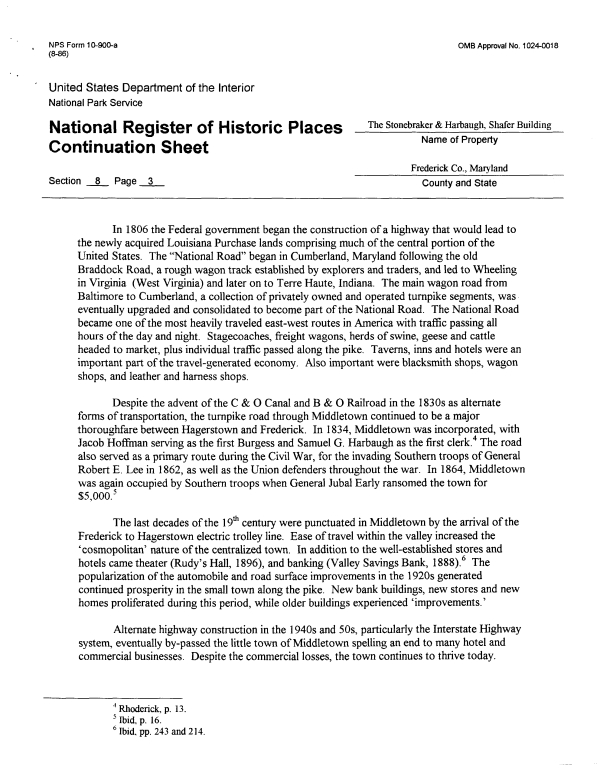 |
||||
|
DEPARTMENT OF HOUSING AND COMMUNITY DEVELOPMENT, MARYLAND HISTORICAL TRUST (Historic Sites Survey) var.d. MSA SE16-6 Image No: se16-6-0268 Enlarge and print image (68K) |
 |
||||
|
DEPARTMENT OF HOUSING AND COMMUNITY DEVELOPMENT, MARYLAND HISTORICAL TRUST (Historic Sites Survey) var.d. MSA SE16-6 Image No: se16-6-0268 Enlarge and print image (68K) |
| NFS Form 1 0-900-a (8-86) OMB Approval No. 1 024-001 8 United States Department of the Interior National Park Service National Register of Historic Continuation Sheet Section 8 Page 3 The Stonebraker & Harbaugh, Shafer Building Name of Property Frederick Co., Maryland County and State In 1806 the Federal government began the construction of a highway that would lead to the newly acquired Louisiana Purchase lands comprising much of the central portion of the United States. The "National Road" began in Cumberland, Maryland following the old Braddock Road, a rough wagon track established by explorers and traders, and led to Wheeling in Virginia (West Virginia) and later on to Terre Haute, Indiana. The main wagon road from Baltimore to Cumberland, a collection of privately owned and operated turnpike segments, was eventually upgraded and consolidated to become part of the National Road. The National Road became one of the most heavily traveled east-west routes in America with traffic passing all hours of the day and night. Stagecoaches, freight wagons, herds of swine, geese and cattle headed to market, plus individual traffic passed along the pike. Taverns, inns and hotels were an important part of the travel-generated economy. Also important were blacksmith shops, wagon shops, and leather and harness shops. Despite the advent of the C & O Canal and B & O Railroad in the 1830s as alternate forms of transportation, the turnpike road through Middletown continued to be a major thoroughfare between Hagerstown and Frederick. In 1834, Middletown was incorporated, with Jacob Hoffinan serving as the first Burgess and Samuel G. Harbaugh as the first clerk.4 The road also served as a primary route during the Civil War, for the invading Southern troops of General Robert E. Lee in 1862, as well as the Union defenders throughout the war. In 1864, Middletown was again occupied by Southern troops when General Jubal Early ransomed the town for $5,000.5 The last decades of the 19th century were punctuated in Middletown by the arrival of the Frederick to Hagerstown electric trolley line. Ease of travel within the valley increased the 'cosmopolitan' nature of the centralized town. In addition to the well-established stores and hotels came theater (Rudy's Hall, 1896), and banking (Valley Savings Bank, 1888).6 The popularization of the automobile and road surface improvements in the 1920s generated continued prosperity in the small town along the pike. New bank buildings, new stores and new homes proliferated during this period, while older buildings experienced 'improvements.' Alternate highway construction in the 1940s and 50s, particularly the Interstate Highway system, eventually by-passed the little town of Middletown spelling an end to many hotel and commercial businesses. Despite the commercial losses, the town continues to thrive today. 4 Rhoderick, p. 13. 5 Ibid, p. 16. 6 Ibid, pp. 243 and 214. |